对文件及文件夹进行修改变更监测有很广泛的应用,例如:
- 通知配置文件的改变
- 跟踪某些关键的系统文件的变化
- 监控某个分区磁盘的整体使用情况
- 系统崩溃时进行自动清理
- 自动触发备份进程
- 向服务器上传文件结束时发出通知
下面给出Java的两种实现,源码可以在GitHub上找到 FileMonitor
JDK1.6及之前版本: 基于Timer实现
两个关键类:
- java.util.Timer
- java.util.TimerTask
Timertask是由Timer执行的实际任务,实现了Rannable接口。通过重写run()方法来指定具体任务细节。
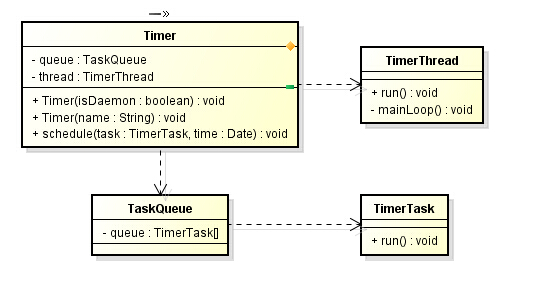 Timer工作原理:
Timer是用于调度一次性执行或重复执行的工具类。通过TaskQueue保存需要调度的TimerTask,当某个Task被废弃时(一次性任务结束或TimerTask.cancel()),将其从该队列中移除。
Timer类维护一个后台线程(守护线程或用户线程,取决于如何创建Timer对象),该线程通常称为Timer任务执行线程。在TimerThread的mainLoop()中依据各个TimerTask的状态和调度时间设定,决定执行或移除TimerTask。
TimerTask应设计为执行不占用太长时间,否则同一个Timer队列中其他的TimerTask的执行将会延迟。
更多可参见:What is Timer and TimerTask in Java
基于Timer的FileMonitor的实现:
Timer工作原理:
Timer是用于调度一次性执行或重复执行的工具类。通过TaskQueue保存需要调度的TimerTask,当某个Task被废弃时(一次性任务结束或TimerTask.cancel()),将其从该队列中移除。
Timer类维护一个后台线程(守护线程或用户线程,取决于如何创建Timer对象),该线程通常称为Timer任务执行线程。在TimerThread的mainLoop()中依据各个TimerTask的状态和调度时间设定,决定执行或移除TimerTask。
TimerTask应设计为执行不占用太长时间,否则同一个Timer队列中其他的TimerTask的执行将会延迟。
更多可参见:What is Timer and TimerTask in Java
基于Timer的FileMonitor的实现:
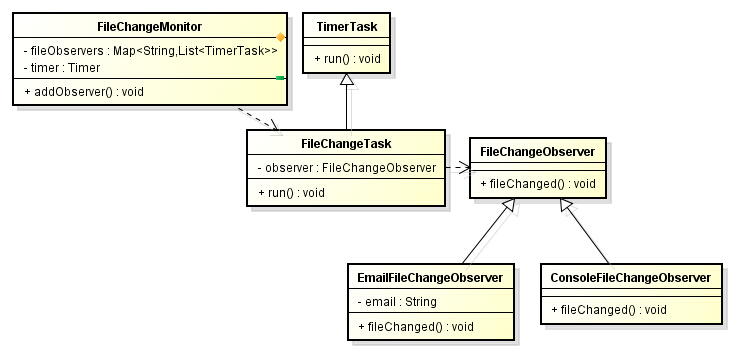
?
通过实现FileChangeObserver接口,该FileMonitor允许对任意文件添加任意多个Observer。
FileChangeMonitor及FileChangeTask源码
FileChangeMonitor本身是一个单例。fileObservers由Collections.synchronizedMap()初始化,保证在该map上的每一个原子操作都将被同步。在其addObserver方法中为每一个fileChangeObserver创建一个FileChangeTask,将其加入fileObservers中。FileChangeTask扩展了TimerTask,由Timer调度执行。
class="java">public void addObserver(FileChangeObserver observer, String filename, long delay) throws FileNotFoundException {
TimerTask task = new FileChangeTask(observer , filename );
List<TimerTask> tasks = fileObservers.get(filename );
if(tasks ==null){
tasks = new ArrayList<TimerTask>();
}
tasks.add( task);
fileObservers.put(filename , tasks );
timer.schedule( task, delay, delay);
}
在FileChangeTask的run()函数中,通过比对时间戳来判断文件是否修改,若发生改动,则通知其Observer进行相应处理。
public void run() {
try {
long newLastModified = file.lastModified();
if (newLastModified > lastModified )[ ] {
lastModified = newLastModified ;[ ]
observer.fileChanged( file.getPath());
}
} catch (Exception e ) {
System. err.println(e .getMessage());
}
}
测试用例FileMonitorTest中为sample1.txt添加了consoleObserver和emailObserver,为sample2.txt添加了consoleObserver。然后对这两个文件分别进行修改。
package com.cwind.file;
import java.io.File;
import java.io.FileOutputStream;
import java.io.IOException;
import org.junit.After;
import org.junit.Before;
import org.junit.Test;
public class FileMonitorTest {
File sampleFile1, sampleFile2 ;
FileChangeMonitor monitor;
ConsoleFileChangeObserver consoleObserver;
EmailFileChangeObserver emailObserver;
@Before
public void setUp() throws Exception {
sampleFile1 = new File("sample1.txt" );
sampleFile2 = new File("sample2.txt" );
monitor = FileChangeMonitor. getInstance();
consoleObserver = new ConsoleFileChangeObserver();
emailObserver = new EmailFileChangeObserver("billchen01@163.com");
}
@After
public void tearDown() throws Exception {
}
@Test
public void testMonitorSampleFile() throws InterruptedException, IOException{
monitor.addObserver( consoleObserver, sampleFile1 .getPath(), FileChangeMonitor.DELAY_TIME );
monitor.addObserver( emailObserver, sampleFile1 .getPath(), FileChangeMonitor.DELAY_TIME );
monitor.addObserver( consoleObserver, sampleFile2 .getPath(), FileChangeMonitor.DELAY_TIME );
FileOutputStream fos1 = new FileOutputStream(sampleFile1 );
FileOutputStream fos2 = new FileOutputStream(sampleFile2 );
fos1.write(0);
fos2.write(0);
fos1.flush();
fos2.flush();
fos1.close();
fos2.close();
Thread. sleep(3000);
}
}
输出结果如下:
Console: File sample1.txt is changed, will print warning message to console.
File sample1.txt is changed, will send email to billchen01@163.com.
Console: File sample2.txt is changed, will print warning message to console.
JDK 1.7 及之后版本:基于WatchService实现
Java 7 的新IO - NIO.2提供了一组新的类和方法,主要存在于java.nio包内。它完全取代了java.io.File与文件系统的交互,并提供了新的异步处理类,无需手动配置线程池和其他底层并发控制,便可在后台线程中执行文件和网络IO操作。
其中Path是新文件IO的基石。为与之前版本兼容,java.io.File类中新增了toPath()方法,Path类中提供了toFile()方法。
Watch Service API可用于将指定目录注册到监视服务上。注册时须指定事件类型,如文件创建、修改、删除等。相关类图如下:
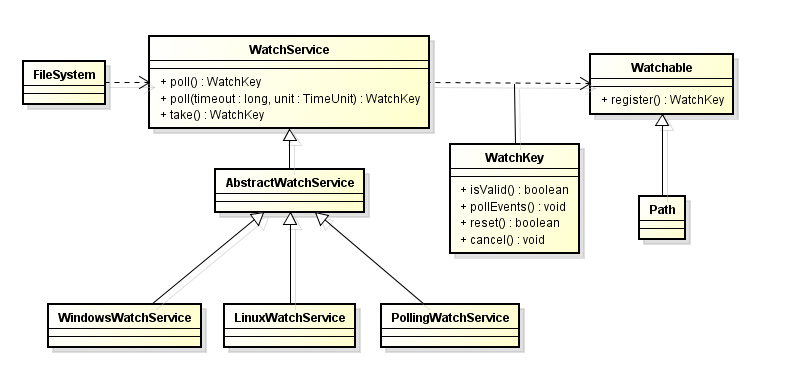
WatchService是监视服务接口,在不同系统上有不同的实现类。实现了Watchable接口的对象方可注册监视服务,java.nio.file.Path实现了此接口。WatchKey表示Watchable对象和WatchService的关联关系,在注册时被创建。注册完成后,WatchKey将被置为'ready'状态,直到下列三种情况之一发生:
1. WatchKey.cancel()被调用
2. 被监控的目录不存在或不可访问
3. WatchService对象被关闭
当文件改动发生时,WatchKey的状态将会被置为"signaled"然后被放入待处理队列中。WatchService提供了三种从队列中获取WatchKeys的方式:
1. poll - 返回队列中的一个key。如果没有可用的key,将立即返回null。
2. poll(long, TimeUnit) - 如果队列中存在可用的key则将之返回,否则在参数预置的时间内等待可用的key。TimeUnit用来指定前一个参数表示的时间是纳秒、毫秒或是其他的时间单位。
例子:final WatchKey watchKey = watchService.poll(1, TimeUnit.MINUTES);将会等待1分钟
3. take - 方法将会等待直到可用的key被返回。
获取WatchKey后进行处理:
1. 通过WatchKey.pollEvents()函数得到WatchEvents列表。
2. 对于每一个WatchEvent,可以通过kind()函数获得其改动类型。
3. 通过WatchEvent.context()函数得到发生该事件的文件名
4. 当该key的所有事件处理完成后,需要调用WatchKey.reset()方法把该key重置为ready状态。若不重置,该key将无法接收后续的改动。若reset返回false,表示该WatchKey不再合法,主循环可以退出。
示例程序:
package com.cwind.file;
import java.io.IOException;
import java.nio.file.Filesystems.html" target="_blank">Systems;
import java.nio.file.Path;
import java.nio.file.Paths;
import java.nio.file.StandardWatchEventKinds;
import java.nio.file.WatchEvent;
import java.nio.file.WatchKey;
import java.nio.file.WatchService;
public class WatchServerTest {
public static void main(String[] args) throws InterruptedException, IOException {
WatchService watchService = FileSystems.getDefault().newWatchService();
final Path path = Paths.get( ".");
final WatchKey watchKey = path.register( watchService, StandardWatchEventKinds.ENTRY_MODIFY ,
StandardWatchEventKinds. ENTRY_CREATE, StandardWatchEventKinds.ENTRY_DELETE );
boolean fileNotChanged = true;
int count = 0;
while (fileNotChanged ) {
final WatchKey wk = watchService .take();
System. out.println("Loop count: " + count );
for (WatchEvent<?> event : wk .pollEvents()) {
final Path changed = (Path) event.context();
System. out.println(changed + ", " + event .kind());
if (changed .endsWith("sample1.txt")) {
System. out.println("Sample file has changed" );
}
}
// reset the key
boolean valid = wk .reset();
if (!valid ) {
System. out.println("Key has been unregisterede" );
}
count++;
}
}
}
?总结,使用WatchService步骤如下:
- 创建WatchService
- 得到待检测目录的Path
- 将目录登记到变化监测名单中
- 执行WatchService的take()方法,直到WatchKey到来。
- 得到WatchKey后遍历WatchEvent进行检测
- 重置key准备下一个事件,继续等待
大多数文件系统实现包含了文件更改通知的本地支持,Watch Service API正是利用了文件系统的这种机制。若文件系统并不支持变更通知机制,Watch Service仍然会轮询文件系统,等待事件产生。
References:
Watching a Directory for Changes
Using Java 7's WatchService to Monitor Directories
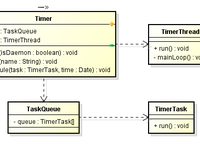
- 大小: 87.2 KB
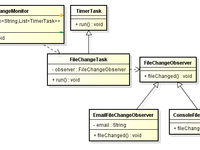
- 大小: 121.1 KB
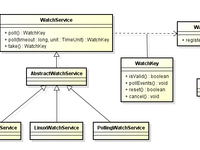
- 大小: 137.1 KB
 Timer工作原理:
Timer是用于调度一次性执行或重复执行的工具类。通过TaskQueue保存需要调度的TimerTask,当某个Task被废弃时(一次性任务结束或TimerTask.cancel()),将其从该队列中移除。
Timer类维护一个后台线程(守护线程或用户线程,取决于如何创建Timer对象),该线程通常称为Timer任务执行线程。在TimerThread的mainLoop()中依据各个TimerTask的状态和调度时间设定,决定执行或移除TimerTask。
TimerTask应设计为执行不占用太长时间,否则同一个Timer队列中其他的TimerTask的执行将会延迟。
更多可参见:What is Timer and TimerTask in Java
基于Timer的FileMonitor的实现:
Timer工作原理:
Timer是用于调度一次性执行或重复执行的工具类。通过TaskQueue保存需要调度的TimerTask,当某个Task被废弃时(一次性任务结束或TimerTask.cancel()),将其从该队列中移除。
Timer类维护一个后台线程(守护线程或用户线程,取决于如何创建Timer对象),该线程通常称为Timer任务执行线程。在TimerThread的mainLoop()中依据各个TimerTask的状态和调度时间设定,决定执行或移除TimerTask。
TimerTask应设计为执行不占用太长时间,否则同一个Timer队列中其他的TimerTask的执行将会延迟。
更多可参见:What is Timer and TimerTask in Java
基于Timer的FileMonitor的实现:
